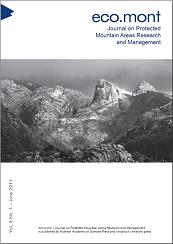Vlatko Andonovski,
Nikolco Velkovskiw
S. 41 - 45
doi:
10.1553/eco.mont-3-1s41
Verlag der Österreichischen Akademie der Wissenschaften
doi:
10.1553/eco.mont-3-1s41
Abstract:
The principal objective of national parks as protected areas is to preserve forest ecosystems, but at the same time they may serve genetic conservation. The Macedonian pine (Pinus peuce Griseb.) is a five-needle pine native to the Balkan peninsula, occupying an area of 2 500 hectares at Pelister National Park (NP). The native populations of Macedonian pine in Pelister NP represent an especially valuable genetic resource for conservation. In situ and ex situ methods were implemented for the conservation of Macedonian pine genetic resources in Pelister NP. In situ conservation has aimed at preserving an existing, native population of Macedonian pine within the community of which it forms a part and in the environment to which it is adapted. An ex situ conservation of Macedonian pine in Pelister NP was also considered and carried out, but only to the extent that it enhanced the goals of the previous in situ genetic conservation activities. The overall conservation approach applied involves preserving not only associated flora, fauna, and ecosystem processes, but maintaining the Macedonian pine populations in Pelister NP within a dynamic environment in which the genetic variation can continue to respond to natural influences.
Macedonian-pine-(Pinus-peuce) Pelister-National-Park genetic-resources in-situ-and-ex-situ-conservation
Published Online:
2011/05/20 07:17:06
Document Date:
2011/05/20 07:16:00
Object Identifier:
0xc1aa5576 0x0028b18d
Rights:https://creativecommons.org/licenses/by-nc-nd/4.0/
The journal “eco.mont” – Journal of protected mountain areas research and management – was published for the first time in June 2009.
The journal was founded as a joint initiative of the Alpine Network of Protected Areas (ALPARC), the International Scientific Committee on Research in the Alps (ISCAR), the Austrian Academy of Sciences (ÖAW) and the University of Innsbruck.
The journal aims to highlight research on and management issues in protected areas in the Alps without excluding other protected mountain areas in Europe or overseas. Its target audiences are scientists from all related disciplines, managers of protected areas and interested individuals including practitioners, visitors, teachers, etc.
The journal presents peer-reviewed articles in English by authors who research protected mountain areas and management issues within these areas. It's published twice a year as a collaboration of the Austrian Academy of Sciences Press – responsible for the e-version – and Innsbruck University Press – responsible for the print version.
Die Zeitschrift „eco.mont“ – Zeitschrift zur Forschung in Gebirgsschutzgebieten – erschien im Juni 2009 zum ersten Mal. Die Zeitschrift wurde auf Initiative des Netzwerks Alpiner Schutzgebiete (ALPARC), der Schweizer Akademie der Naturwissenschaften (ISCAR), der Österreichischen Akademie für Wissenschaft (ÖAW) und der Universität Innsbruck gegründet. Sie hat das Ziel, Themen zu behandeln, die gleichzeitig Forschung und Verwaltung in und über die Schutzgebiete der Alpen betreffen, ohne dabei andere Gebirgsschutzgebiete Europas oder anderswo auszuschließen. Diese neue Zeitschrift richtet sich an ein Publikum von Wissenschaftlern der verschiedensten Fachbereiche, an die Verwalter von Schutzgebieten und an alle sonstigen Interessierten, Praktiker, Besucher, Lehrpersonal etc. einbegriffen. Die Zeitschrift veröffentlicht begutachtete Beiträge auf Englisch von Autoren, die Fragen der Gebirgsschutzgebieten und deren Verwaltung forschen. Sie erscheint zweimal pro Jahr, auf der Basis der gemeinsamen Anstrengungen des Verlags der Österreichischen Akademie der Wissenschaften, der für die digitale Fassung verantwortlich ist, und der Presse der Universität Innsbruck, verantwortlich für die gedruckte Fassung.



 Home
Home
 Print
Print
 References
References
 Share
Share

